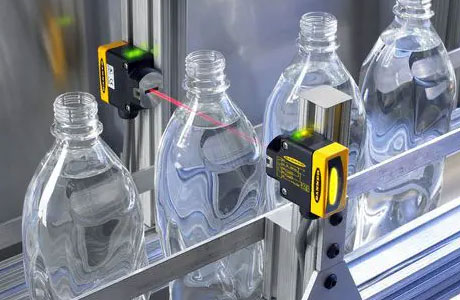Key Takeaway
A photoelectric sensor detects the presence, absence, or distance of an object using a light transmitter and receiver. The transmitter emits light, often infrared, and the receiver detects the light. When the light is interrupted or reflected by an object, the sensor identifies the change.
These sensors are commonly used in industries like manufacturing, where they ensure the precise detection of objects on conveyor belts and in packaging systems. They are highly valued for their accuracy and reliability, making them essential in automation and quality control processes.
The Core Purpose of Photoelectric Sensors in Industrial Systems
At their core, photoelectric sensors detect objects by using light. These sensors emit a light beam, often infrared or visible light, and detect any interruption in this beam caused by an object. This interruption triggers a response, which can be anything from stopping a machine to counting a product. The primary function is simple: detect and react to the presence or absence of an object in the sensor’s path.
In industrial systems, these sensors play a critical role. They are used in assembly lines, packaging, and quality control systems, ensuring smooth operations by instantly recognizing product movements or blockages. Imagine a conveyor belt moving items swiftly. A photoelectric sensor ensures that no product is missed, misaligned, or overcounted. It’s a simple, yet highly effective technology that’s integral to maintaining efficiency.

Key Functionalities: Object Detection, Distance Measurement, and Counting
Imagine you’re in a fast-paced warehouse, where thousands of packages move through the system daily. This is where photoelectric sensors become invaluable. They don’t just detect objects; they measure distances with precision and even count items passing through beams. It’s their versatility that makes them indispensable in automated environments like factories and distribution centers. Object detection is the most basic function, but the real magic happens when they do so without physical contact. Non-contact detection means less wear and tear compared to mechanical switches, leading to longer sensor life.
Now, think about how critical this becomes when measuring the distance between objects, whether they’re small and close or large and further away. In high-speed environments, accurately counting objects as they move along the production line is essential. A malfunction here could cause costly errors and delays. These sensors help industries optimize their processes, avoid mistakes, and ultimately improve efficiency, making them a key component in modern industrial setups.
Industrial Processes That Depend on Photoelectric Sensors
In any modern industry, efficiency is the name of the game, and photoelectric sensors are at the heart of this. For example, in packaging plants, these sensors ensure that products are properly packed and there are no gaps in the process, ensuring smooth operation. In the automotive sector, where precision is paramount, these sensors help in the assembly of car parts, detecting whether each piece is perfectly positioned on the production line.
Their importance skyrockets in industries like food and pharmaceuticals. In food processing plants, hygiene and precision are non-negotiable. Sensors monitor fill levels, check packaging integrity, and ensure everything is sealed properly. Meanwhile, in the pharmaceutical industry, these sensors detect any misplaced or missing items, ensuring every product meets stringent standards. Without these sensors, these processes could slow down or become prone to errors, leading to inefficiencies and even safety risks.
Differences Between Various Types of Photoelectric Sensors
When choosing the right sensor for the job, it’s important to understand that not all photoelectric sensors are built the same. There are three main types: through-beam, retro-reflective, and diffuse-reflective sensors. Each has its unique strengths depending on the industrial application. Through-beam sensors, for instance, offer the longest detection range because they use two separate units—one emits light, and the other receives it. They are perfect for applications that require high accuracy over longer distances.
On the other hand, retro-reflective sensors rely on a reflector to bounce the light back to the receiver. These are often used for detecting shiny or reflective objects. Finally, diffuse-reflective sensors detect objects by sensing the light reflected directly from the object. This makes them ideal for shorter-range applications where high precision is not as critical. By understanding these differences, industries can choose the best sensor to match their needs, optimizing performance and accuracy.
How Photoelectric Sensors Improve Productivity and Safety
You can’t overlook the role of photoelectric sensors in boosting both productivity and safety in industrial settings. For example, in high-risk areas where machinery is involved, photoelectric sensors can prevent accidents. Imagine a machine that halts automatically if a worker’s hand crosses a sensor’s beam—that’s a game-changer for safety. In many industries, this kind of protection isn’t just a perk; it’s a necessity for maintaining a safe work environment.
In terms of productivity, these sensors help keep operations running smoothly. They detect issues like misaligned products or machinery jams in real time, minimizing costly downtime. The ability to keep machines running faster and more accurately while reducing errors means fewer bottlenecks and a significant boost in efficiency. Photoelectric sensors ensure that automated processes not only meet the high demands of modern production lines but also help companies maintain a safe, productive workspace.
Conclusion
Photoelectric sensors are integral to modern industrial automation, ensuring precision and safety across various applications. They detect objects, measure distances, and count items, facilitating seamless operations on production lines. Their ability to enhance efficiency, ensure worker safety, and support the automation of complex processes makes them indispensable in today’s fast-evolving industries. As technology advances, the importance of these sensors will only grow, solidifying their role as the backbone of automated systems. Understanding their function is crucial for engineers involved in optimizing industrial workflows.
